6 Dock Trials
6.1 Control Heads (Engines Stopped)
A Turn power ON to the Control System.
B The Control Head at each Remote Station should produce an intermittent tone.
C Perform each of the following steps on all Remote Stations.
1. Move the Control Head’s lever(s) full Ahead and full Astern. Ensure that there are no
obstructions to the movement, the Processor reacts to the lever movement, and that no
tones are generated.
2. Place the Control Head’s lever(s) in the Neutral position.
3. Depress and hold
the Station transfer button while moving the Control Head’s lever(s) to the
Ahead detent. Release the transfer button.
• The red LED on the Control Head should blink, indicating Warm-up Mode has been
entered. Warm-up Mode only
operates in the Ahead direction.
6.2 Start Interlock (Engines Stopped)
A Turn the Processor DC power OFF.
• Verify that the engine(s) will not
start.
B Turn Processor DC power ON. Do not
take command at a Remote Station.
• Verify that the engine(s) will not
start.
C Take command at a Remote Station. Place the Control Head’s lever(s) to approximately 50% of the
throttle range.
• Verify that the engine(s) will not
start.
D Place the Control Head’s lever(s) in the Neutral/Idle position. Take command at a Remote Station.
• Verify that the engine(s) will
start in this position.
6.3 Engine Stop Switches
• Start the engine(s) and verify that the Stop switches (normally push buttons) function correctly
at all Remote Stations.
6.4 Push-Pull Cables
A Check that all Push-Pull cable connecting fasteners are tightened securely.
B In the Processor(s) check that the Push-Pull cable jam nuts are securely tightened. A loose hex nut
can back off the Push-Pull cable threaded end and effectively change the cable length.
WARNING: It is imperative that the information provided in the previous Sections has been read and followed
precisely, prior to attempting a Dock Trial.
CAUTION: With I/O or Outboard applications, do not attempt to shift into or out of gear with engines stopped.
This may cause a jam condition or damage to the linkage to some clutch configurations.
NOTE: On twin screw applications, the following tests must be performed on both sides. If any of the following
tests fail, consult section Section 10: Troubleshooting.

